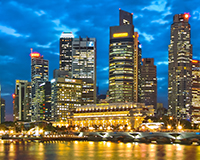 Right in the geographic heart of the Asia-Pacific region is a group of 10 countries often referred to as South East Asia – namely Singapore, Indonesia, Cambodia, Malaysia, Brunei, Vietnam, Thailand, Myanmar, Laos and the Philippines. They form an economic grouping called ASEAN, which is rather like the EU except it focuses entirely on free trade rather than political union.
Right in the geographic heart of the Asia-Pacific region is a group of 10 countries often referred to as South East Asia – namely Singapore, Indonesia, Cambodia, Malaysia, Brunei, Vietnam, Thailand, Myanmar, Laos and the Philippines. They form an economic grouping called ASEAN, which is rather like the EU except it focuses entirely on free trade rather than political union.
I used to think of this area as all about palm trees, beaches, rubber plantations, temples, noisy markets and mopeds. Such features do still exist, but now that I have spent time in these markets I better understand their huge commercial potential.
ASEAN has a population of 625m and if it were a single economy it would rank as the 7th largest in the world (just behind the UK). The wealth is dramatically uneven, however: in Singapore GDP per head is $50,000, whereas in Laos it is $1,300. This makes it impossible for ASEAN to implement an EU-style free movement of labour programme (apart from a very narrowly defined list of nine professions, including doctors, dentists and, interestingly, surveyors).
There’s a young, large and growing population, a wealth of agriculture and commodities, a growing manufacturing sector (in part driven by companies looking to diversify from China), a growing service sector, a growing middle class and (as a result) a growing occupier demand for quality offices, retail, logistics and leisure property. So is there a queue of international real estate investors looking to ride the wave?
For various reasons, the answer is no. Most of the countries that make up ASEAN have a lack of transparency in their property markets and some also have government restrictions on foreign ownership, often a hangover from colonial days. The development process is hugely complex, with uncertain land rights and unpredictable application of government regulations. Once built, investment properties are often sold off floor by floor to a mix of small investors and occupiers so that the institutional-quality investible stock is very limited. Much of the land and commercial real estate is owned by family controlled conglomerates who rarely sell.
This is all illustrated by a startling statistic. In 2015, the value of the commercial real estate bought and sold in the EU was $235bn; the equivalent number in ASEAN was $12bn.
This lack of liquidity and buying opportunities is frustrating to international investors because there are great returns to be made. Jakarta has amazing demographics and a shortage of quality space, Manila is booming due to a surge in the international BPO market, and Bangkok and Kuala Lumpur provide tempting investment income opportunities.
If ASEAN wants to attract more international investment and make the recycling of capital faster and more efficient, its property markets will need to be made less opaque and more accessible. Currently only the more opportunistic investors get involved and they want high returns to compensate for the risk.
There is one very obvious exception. There is a country within ASEAN that has got it right. Singapore has a very efficient, transparent market within a strong and clear regulatory framework and is by far the favourite with international investors, who see it as their gateway to South East Asia.
There are huge property opportunities in the rest of ASEAN, but those without strong local understanding need to tread extremely carefully and, of course, take lots of advice.
Alastair Hughes is chief executive, Asia-Pacific at JLL











